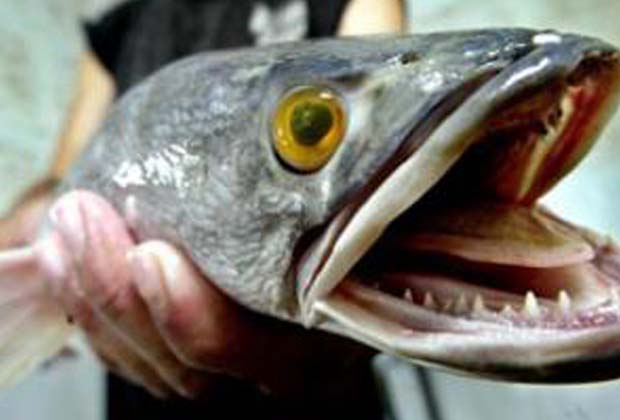There’s Asian carp in ‘tribs’ of the Mississippi River threatening the Great Lakes. There’s lionfish devouring the reef fish of the U. S. and Bahamas. There’s snakeheads in the Potomac River and canals of Broward County, Florida. There’s Pacific salmons in all of the Great Lakes as well as steelhead. Attempts to plant Atlantic salmon in Lake Huron haven’t yet proven to be sustainable. Brown trout are everywhere. All of the latter are considered exotics and are positively non-native in their aforementioned coordinates.
Scientists shed an interesting light on a few non-native fish species that stirred-up the whacko birds in the press, including the New York Times and the Washington Post.
Snakeheads, Walking Catfish and the Asian Swamp Eel
[dropcap]P[/dropcap]ress accounts of the Asian snakehead fish ‘invading’ New York City continue to perpetuate the distorted doomsday image earlier media accounts fostered when this story first broke following the discovery of a few Northern Snakehead in a small Maryland pond in 2002.
Such stories often contain far more Hollywood-like hype than science according to a group of learned scientists in Florida who collectively have more than 100 years of professional experience working with exotic freshwater fishes. Unfortunately, accuracy has frequently been abandoned in pursuit of sensational headlines and quotations. Even the highly respected New York Times referred to snakeheads in an August 9, 2005 story as “devilish” and “nightmarish creatures from Asia,” playing off of earlier accounts, such as the Washington Post’s July 3, 2002 story that describes snakeheads as “something like killer bees that swim” and “diminutive whiskered land sharks, gobbling up every fish snack in sight.”
In reality, the name ‘snakehead’ refers to a group of 29 freshwater fishes that are native to China, Thailand, Sri Lanka, the Philippines, India, and parts of tropical Africa. Although snakeheads have recently been illegally introduced into several States, only two species are reproducing in the continental United States. These are the Northern Snakehead, which is reproducing in the Potomac River and a South Philadelphia pond, and the Bullseye Snakehead, which is reproducing in a southeast Florida urban canal system.

Bullseye snakehead (Channa marulius) caught in an industrial park ditch in Coral Springs, Florida.
Look to left, that ditch is only 6-inches deep and poorly oxygenated. Photo credit The University of Georgia – Center for Invasive Species and Ecosystem Health.
“Unfortunately, the public is reading, hearing, and seeing reports describing these fishes as ‘Frankenfish’ or the ‘fish from hell,’ said Paul Shafland, a fisheries scientist who has spent more than 30 years studying exotic fish at the Florida Fish and Wildlife Conservation Commission’s (FWC) Non-Native Fish Laboratory in Boca Raton. But Shafland urges the public to be skeptical about some of the things they have heard and read about these fishes, and most notably the Northern Snakehead.
According to some accounts “This alleged monster eats anything in its path, can walk on land, survive up to three days out of water, and will even attack and kill people when guarding its young!”
“That’s great story lines for Hollywood movies, but it is not accurate news,” Shafland said.
Dr. Walter R. Courtenay (Professor Emeritus and leading federal expert on snakeheads) agrees, and tells everyone who will listen that “I assure you that the Northern and Bullseye snakeheads are incapable of overland movements.” Moreover, Courtenay adds that any such ‘land’ movements by any snakehead “must occur during the monsoon season so snakeheads can keep their bodies and breathing organ moist or else these fish will die in a matter of hours, not days!”
Dr. Jeffrey Hill (Lead Fish Researcher at the University of Florida’s Tropical Aquaculture Laboratory) agrees, adding that “Snakeheads cannot survive drying out nor can they make extended overland migrations across dry ground, although that seems to be the message popularized in media accounts.” Remember, he said “Snakeheads are fish, fish need water, and even though snakeheads can use atmospheric oxygen unlike most other fishes, they must remain moist to do so.”
“The appearance of any illegally introduced exotic fish is cause for concern, but not the recent hysteria we’ve been reading about with the snakehead. This is not a short-term crisis, but a long-term problem with less than catastrophic but no less real and unpredictable consequences” said Jon R. Fury, FWC Senior Fisheries Scientist for the South Florida Region.
The legend of snakehead voraciousness is built upon very few, if any hard facts, many of which have in turn been taken out of context and grossly exaggerated. Trying to debunk some of these snakehead myths Courtenay, Fury, Hill, and Shafland all agree that: Ads
- Yes, snakeheads can ‘breathe’ air and live out-of-water longer than most fish can, but suggestions that these fish can live without water for up to three days is a gross exaggeration.
- Yes, snakeheads can move through shallow water, swampy conditions, and even semi-fluid mud that would immobilize many native fishes. But on dry land they only flop, wriggle, and squirm their way along for short distances, after which they will die in a matter of hours, not days.While there have been some local reports of snakeheads being found alive on land in their native ranges, none of the 29 Snakehead species possess the ‘land-walking’ attributes and abilities of the Walking Catfish, which has been in Florida since 1967. And even the Walking Catfish cannot live unless kept in a moist environment.
- Neither the infamous Northern Snakehead nor its cousin the Bullseye Snakehead are capable of making overland migrations or land movements of any kind.
- Yes, snakeheads are predators with small sharp teeth that are very similar to the native Bowfin but, NO, it is not some finned tiger waiting to pounce upon every living thing, nor is it able to single-handedly wipe out native fish communities.
- Another truth is that the illegal introduction and presence of reproducing snakeheads in Florida, the Potomac River, and a South Philadelphia pond is a serious concern, one that should be dealt with in a commensurately serious manner.
“Let me assure you that the discovery of the Bullseye Snakehead in Florida waters is not something to dismiss lightly,” Fury said. “In some cases, the presence of an exotic species can alter the ecosystem to the detriment of native species.”

If you’re in Broward County, Florida and have a copy of this book, access to a fly rod or spinning gear, the author of this book will step by step, and location by location, show you how to catch snakeheads. In the past, Kantner has led fly anglers to IGFA world record snakehead catches.
“In such cases as this, we follow our well-established protocol for dealing with these matters rather than running about shouting: ‘The sky is falling! The sky is falling!’” Shafland said. “And this is not the first time that an exotic fish has stimulated such an end-of-the-ecosystem-as-we-know-it type of hysteria; in fact, it is very reminiscent of the same distorted coverage the Walking Catfish received back in the late 1960s and 70s.”
“Now we know that all the gloom and doom predictions about the Walking Catfish in 60s and 70s were unfounded,” Courtenay said. “Do we still have Walking Catfish in Florida? Yes. Are they a problem? Yes, but their documented negative impact on native freshwater species has been negligible compared to the catastrophe they were projected to be in media accounts.”
“These stories never seem to die; they just seem to lie dormant until a new species is reported that has an especially unusual appearance, behavior, and/or even just a strange name” Hill said. A few years ago similar stories surfaced about the Asian Swamp Eel that generated similar concerns by the public.
The real story here is that numerous unwanted exotic animals continue to be released into North America and elsewhere by well-meaning but misinformed individuals. Not only is this illegal, it is ecologically irresponsible, and often harmful to the animal itself
“How would you like to be dumped in the Antarctic or in the middle of a rain forest far from anything you were familiar with, to fend for yourself” Shafland rhetorically asks. Most of these illegally released animals die premature deaths because they are unable to adjust to their new surroundings. But those that do survive and reproduce can create serious problems for species and wildlife managers.
Shafland points out that 32 exotic fish species have been found reproducing in Florida’s freshwaters, and 22 of these are considered permanent residents.


